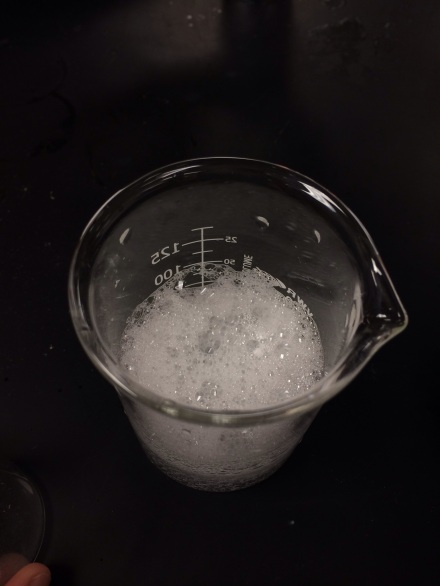A Bronsted-Lowry acid-base reaction witch transports a H+ ion from one molecule to another. A stronger acid will contain more H+ ions and the base will have less. The acids are "donors" while the bases are "acceptors" Strong acids dissociate into weak conjugate bases, and weak acids dissociate into strong conjugate bases. All acid base equations react into a neutralized reaction. They are ionic meaning the H+ atoms increase, but do not change the number in Oxygen. Titration is a method for quantitative chemical analysis of unknown concentration of an identified component. The empirically determined concentration of a given sample of sulfuric acid is
Thursday, September 25, 2014
Sunday, September 14, 2014
Three Questions
Recently I just preformed a lab on electrolysis of water. We've been studying solutions and colloids and the Tyndall effect. I am understanding the concepts and ideas established in this lesson. I hope to continue to build my knowledge in chemistry and get better with my stoichemotery.
Electolytes and Water
Recently we worked with ionized and deionized water. We had to recreate the three different types of the ionized water. One was just distilled water, the other had a low concentration of electrolytes, and the other was comprised of a high concentration. We found out that the increase of salt gave the water a higher concentration, and the addition of distilled water lowered it. The electrolytes are ionic compounds containing both cations and anions that were dissociated in the solvent. The solvent produced negative and positive charges and conducted electricity. A solute is what is dissolved, hence the salt, and the solvent is what does the dissolving. A solution is a homogeneous mixture of two pure substances. An example of a particle diagram would show that the Cl-ions are attracted to the hydrogen atoms and the Na+ atoms are attracted to the oxygen atoms.
There are two different concentrations of salt solutions that can be qualitatively demonstrated in the pictures shown below. By adding less salt to the beaker of water, we were able to cause the light to become dimmer. If we added more salt to the water the light would become brighter. You can mathematically show the difference in concentration by finding the molarity. For example, you can use moles of salt all over the liters of the solution for molarity. You can also use the and also moles of salt over the kilograms of water. To figure out which beaker is the distilled water, low concentration, and high concentration, you use a electricity conducting tool which will show you the amount of electricity that was produced. Obviously the DI water had no ionization within it, so there was no electrolytes. The salt water contained cations and anions, and had a high concentration, because of this the electrolytes and water were attracted to the salt. The tap water is ionized, but due to a low concentration, it didn't produce a lot of electricity.
Sunday, September 7, 2014
These and Those Lab
Our last lab was the These guys and those guys. It was the combination of the sodium bicarbonate and acetic acid, otherwise known as baking soda and vinegar. we observed to see how much O2 and H2O we could produce. The chemical reaction is
NaHCO3+HCH3COOH—>CO2+H2O+NaCH3COO.
We performed multiple attempts during this lab, but I was only present for one of the days. We used a variety amount of baking soda between (.25-4.00 grams) and adding it to two finger width amount of baking soda . We found out that the limiting reactant is the vinegar because of the increase of baking soda. Our experiment results produced to much CO2 and didn't react fully.
This experiment helped verify stoich relationships and to review limiting reactions. Using the masses obtained from the experiment it is possible to calculate the theoretical number of grams produced and/or lost, therefore verifying the stoich relationships.

NaHCO3+HCH3COOH—>CO2+H2O+NaCH3COO.
We performed multiple attempts during this lab, but I was only present for one of the days. We used a variety amount of baking soda between (.25-4.00 grams) and adding it to two finger width amount of baking soda . We found out that the limiting reactant is the vinegar because of the increase of baking soda. Our experiment results produced to much CO2 and didn't react fully.
This experiment helped verify stoich relationships and to review limiting reactions. Using the masses obtained from the experiment it is possible to calculate the theoretical number of grams produced and/or lost, therefore verifying the stoich relationships.

Tuesday, September 2, 2014
Three Questions
Recently we completed the baking soda and vinegar lab. We have also been reviewing and reviewing stoichemetry, and moles. Tomorrow we have a test and I'm extremely nervous. Hopefully I will remember what to do, the math and get an A.
Subscribe to:
Comments (Atom)

